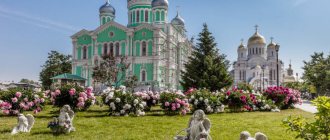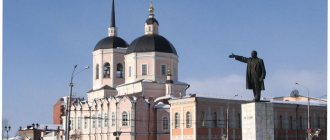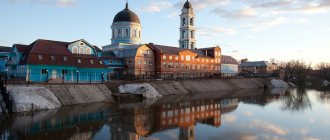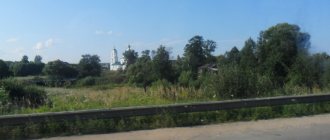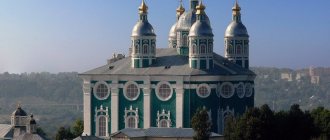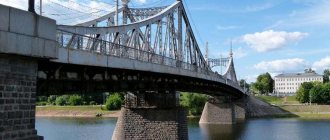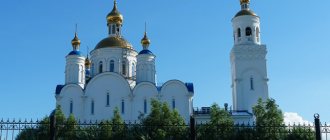The settlement of Belokholunitsky crossing in the Slobodsky district of the Kirov region, Russia is also sometimes called “White Kholunitsa”.
City in Kirov Oblast, Russia
| White Kholunitsa White Kholunitsa | |
| Town[1] | |
| General Directorate, Belaya Kolunitsa | |
| Flag Coat of arms | |
| Location Belaya Kholunitsa | |
| White Kholunitsa Location Belaya Kholunitsa Show map of Russia White Kholunitsa Belaya Kholunitsa (Kirov region) Show map of Kirov region | |
| Coordinates: 58°51′N 50°52'E / 58.850°N W. 50.867°E / 58.850; 50.867Coordinates: 58°51′N 50°52'E / 58.850°N W. 50.867°E / 58.850; 50.867 | |
| A country | Russia |
| Federal subject | Kirov region[1] |
| Administrative region | Belokholunitsky district[1] |
| Town | White Kholunitsa[1] |
| Based | 1764[2] |
| City status from | 1965 |
| Height | 140 m (460 ft) |
| population (2010 Census)[3] | |
| • General | 11,232 |
| • Evaluate (2018)[4] | 10,406 (−7.4%) |
| Administrative status | |
| • Capital from | Belokholunitsky district[1], Belaya Kholunitsa[1] |
| Municipal status | |
| • Municipal district | Belokholunitsky municipal district[5] |
| • Urban village | Belokholunytskoye village[5] |
| • Capital from | Belokholunytsky municipal district[5], urban-type settlement Belokholunytskoye[5] |
| Timezone | UTC + 3 (MSK [6]) |
| Postal code(s)[7] | 613200 |
| OKTMO I WOULD | 33605101001 |
White Kholunitsa
(Russian: Belaya Kholunitsa) is a town and the administrative center of Belokholunitsky District in Kirov Oblast, Russia, located on the Belaya Kholunitsa River (Vyatkas tributary), 82 km (51 mi) northeast of Kirov, the administrative center of the region. Population: 11,232 (2010 Census);[3]11,975 (2002 Census);[8]13,367 (1989 Census).[9]
Previously he was known as Kholunitsky
,
Belokholunitsky
.
Recommendations
Notes
- ^ a b c d f g gram hour
Law No. 203-ZO - ^ a b Encyclopedia of Russian Cities
. Moscow: Great Russian Encyclopedia. 2003. p. 39. ISBN 5-7107-7399-9. - ^ a b
Federal State Statistics Service of Russia (2011).
“All-Russian Population Census 2010. Volume 1" [All-Russian Population Census 2010, vol. 1]. All-Russian Population Census 2010 [All-Russian Population Census 2010]
(in Russian). Federal State Statistics Service. - "26. The size of the permanent population of the Russian Federation by municipalities as of January 1, 2022.” Federal State Statistics Service. Retrieved January 23, 2022.
- ^ a b c d f
Law No. 284-ZO - "On the calculation of time." Official Internet portal of legal information
(in Russian). June 3, 2011. Retrieved January 19, 2022. - Post office. Information and computing center of OASU RPO. ( Post office
).
Search for postal facilities ( Search for postal facilities
) (in Russian) - Federal State Statistics Service of Russia (May 21, 2004). “The population of Russia, the constituent entities of the Russian Federation as part of federal districts, urban settlements, urban settlements, settlements, settlements of 3 thousand or more people.” [Population of Russia, its federal districts, federal subjects, districts, urban settlements, rural settlements - administrative centers, rural settlements with a population of more than 3000 people] (XLS). All-Russian Population Census of 2002 [All-Russian Population Census of 2002]
(in Russian). - “All-Union Population Census of 1989. The actual population of the union and autonomous republics, autonomous regions and districts, territories, regions, urban settlements and villages of the Vyatka region,” No. 227 (4115), December 11, 2007 (Legislative Assembly of the Kirov Region. Law No. 203-ZO of December 4, 2007 On the register of administrative-territorial units and settlements of the Kirov region
As amended by Law No. 350-ZO of November 11, 2013
On amendments to various laws of the Kirov region
Valid the next day after ten days after the day of official publication.). - Legislative Assembly of the Kirov region. Law No. 284-ZO of December 7, 2004 “On establishing the boundaries of municipalities of the Kirov region and granting them the status of a municipal district, city district, urban settlement, rural settlement,” as amended. Law No. 350-ZO of November 11, 2013 “On amendments to certain Laws of the Kirov Region.” Came into force after 10 days from the date of official publication. Published: “Vyatka Territory”, No. 233–234 (3401–3402), December 21, 2004 (Legislative Assembly of the Kirov Region. Law No. 284-ZO of December 7, 2004. On establishing the boundaries of municipalities of the Kirov Region and assigning them status municipal district, urban district, urban settlement, rural settlement
As amended by the Law of November 11, 2013 No. 350-ZO.
On amendments to various laws of the Kirov region
. Valid after 10 days from the date of official publication.).
Travel to Belaya Kholunitsa: holy places, an almost endless pond and terrible legends
Belaya Kholunitsa is a small town about 80 kilometers northeast of Kirov. The main attraction of the city is the Belokholunitsky pond, or rather the reservoir. Many Kirov residents go to it on vacation, but few people know that the history of the creation of this reservoir is connected with the founding of the city itself. Besides the pond, there are beautiful old buildings, temples and holy places. Well, and the best part: during the trip, we traditionally hid for you coupons for 40 liters of gasoline from the Dvizhenie gas station. Overall, there is definitely something to see and do here. But let's take things in order.
What the article says:
- How to get there
- We walk along the embankment and get to know the city
- Studying architecture
- Sunbathing on the beach
- Let's learn scary legends and try healing water
How to get there
We got from Kirov to Belaya Kholunitsa in about 1.5 hours. You need to take the P166 highway through Vakhrushi and Slobodskaya. Before entering Belaya Kholunitsa, we stopped at the Dvizheniye gas station so as not to be left with an empty tank during the trip. After filling up the car, we bought ice cream and cold water here - we couldn’t do without this on a hot July day.
We walk along the embankment and get to know the city
We started our route around the city with a walk along the embankment near Belokholunitsky Pond. The place is very pleasant: it is clean, cozy and quiet, there are benches where you can sit and admire the beautiful view. The Belokholunitsky pond is simply huge, it is the largest artificial reservoir in the Kirov region - its area is 15 square kilometers.
It was created in the middle of the 18th century after iron ore deposits were discovered here. The mines were bought by Prosecutor General A.I. Glebov and built a large ironworks on the Belaya Kholunitsa River. To make the factory mechanisms work, it was necessary to create a dam and reservoir as a source of motive power. For construction, serfs were brought here from the Novgorod and Vologda provinces. In September 1764, a ceremonial closure of the river with a wooden three-sluice dam took place. The work lasted for about 4 hours, and eventually the river turned into its new wooden channel. After the sluices were closed, the reservoir gradually began to fill with water and occupied an area of several tens of kilometers. From that moment on, the pond was deepened and expanded several times, and in 1812 even French prisoners carried out this work. This is how a large and picturesque reservoir appeared in the northeast of the Vyatka province. The date of the damming of the river is considered the founding day of Belaya Kholunitsa, since thanks to the creation of the plant, first a factory village and then a city appeared here.
The water in Belokholunitsky Pond is clean, the color of a clear blue sky. The shore on this side is strewn with large pebbles, and the opposite one is very far away, so it seems as if you are at sea. In hot weather, this place is especially reminiscent of the Russian south: hot paving stones, scorching sun, almost endless water surface. The only thing missing is stalls with hot corn and ice-cold kvass on tap.
There are no fountains or sculptures on the embankment. Only at the very beginning you will see a pile of stones with an anchor on top. This is a stone stele that was installed on the shore of the pond in 2009 at the initiative of the local administration. By the way, the anchor was raised from the bottom of the reservoir during a cleanup in 2005. Next to the stele there is a memorial plaque on which it is written how and when the pond appeared here.
Studying architecture
To the right of the embankment there is a small park where you can hide from the sun. There are two monuments installed in it: the Civil War Memorial and the monument to “Countrymen - Heroes of the Great Patriotic War”.
If you go further along the coast, you will see a beautiful two-story red brick mansion (Lenin St., 2). Previously, this was the residence of the managers of the Kholunytsky plant, and now it is the building of the White Kholunytsky secondary school No. 2.
After the October Revolution, the building was nationalized; public organizations, a proletarian playground, a labor school, a pedagogical college, and an evacuation hospital operated in it. The house was given to the school in 1955.
This mansion is a striking monument of civil architecture of the eclectic period. The porch and the front two-flight staircase inside the building deserve special attention.
Not far from the school there is a local history museum (Usatovaya St., 2). The building was built in 1893, until 2010 it housed the main administration of the Kholunitsky factories. The museum's porch is decorated with a cast-iron umbrella; in the center of the pediment composition is a heraldic cartouche with the family coat of arms of the owner of the factories. Inside, the building is decorated with a cast-iron staircase to the second floor, its railing in the form of figured balusters is an example of masterful volumetric casting. In front of the museum there are information stands with interesting historical facts about the creation of the plant and the city.
Nearby there is a city cultural center and a small fountain. About a 5-minute walk from here there is another interesting building - the Clergy House (Lenin St., 22). This is a brick two-story house with a large basement. It was built in the second half of the 19th century for the ministers of the local Trinity Church. The site was very swampy, which is why the building took nine whole years to erect, and after construction was completed, its height was periodically increased, because the foundation was sinking significantly. It is believed that eventually the foundation of the house became the same in height as the building itself. A priest, a deacon and a psalm-reader lived in the house, and after the October Revolution, public organizations and a secondary school for working youth were located here. For some time, People's Commissar of the Navy Pyotr Smirnov lived in the building. Later, a memorial plaque was placed on the facade of the house.
Sunbathing on the beach
The cultural part of the trip is over for now. Then we go to the beach, on the way there you will pass the building where a lace making school was opened in 1898 (Smirnova St., 20). There, girls from families of factory workers and peasants received a rare specialty. Now it houses a children's art house.
The beach in Belaya Kholunitsa is ideal for families with children. The shore is sandy and flat, and the depth of the pond increases gradually: it seems like an eternity passes while you walk to a place where you will be hidden at least up to your shoulders. Therefore, you can let kids who can’t swim into the water without fear.
There are no changing cabins, no toilets, no sun loungers, no ice cream wagons, only sand that burns your heels, pine trees casting shadow on the beach, and cool water. Despite this, there are a lot of people here.
After swimming you can have a snack. There are several cafes in the city; after studying the reviews on Yandex.Maps, we stopped at Cafe No. 4 (Yubileinaya St., 28a). The choice of dishes there is good: there are salads, hot dishes, soups, pastries, cold and hot drinks. I took kvass, which tasted just like grandma’s, fresh cabbage salad and crispy buttery cheburek with potatoes. Lunch turned out to be very cheap - about 80 rubles.
Let's learn scary legends and try healing water
Then we go to Klimkovka to the holy spring “Manigor”, or the source of the Flaming Babies. The history of this place is connected with an old legend, according to which in 1883 the peasant Georgy Voronin killed his three sons. While the mother with her two eldest sons Grigory and Kirill begged for alms at the Klimkovo plant, and her daughter Maria took a cow to the spring, the man was alone with the children. The babies cried so much from hunger that the father lost consciousness and threw the babies into a burning stove, and then burned the entire house to the ground. According to legend, soon at the site of the tragedy a spring with the purest healing water emerged from the ash.
The road from the cafe to Klimkovka takes 30 minutes. The village greets travelers with the destroyed Temple of the Savior Not Made by Hands, a small pond and the ruins of the Klimkovsky iron smelting plant. It is located on the outskirts of Klimkovka, a sandy forest road leads there. The spring is very quiet, because of this the singing of birds and the murmur of water can be heard especially well. The water in it is clean, very cold and tasty; in the heat it is a real salvation.
The place is beautiful, you can see that it is being looked after: it is very clean, the gazebos and the chapel seem to have just been painted. If you turn left from the springs, you will reach the font. The descent to it is a separate pleasure: you go down, watch how the sun’s rays try to break through the trees, the sun plays on the leaves, on the left hand there are thickets of ferns, and on the right the source gurgles and shimmers. After a couple of minutes of descent you will see a font in which you definitely need to swim. There is silence, there is absolutely no one around, this makes it very pleasant to be here: you feel peace. So that you are not too lazy to get to this place, cutting off the route at Belaya Kholunitsa, we hid the bottle here.
Here's how you can find it:
1. get to "Manigor";
2. stop at the fence made of poles and walk along it to the left;
3. find an old tire, the bottle is hidden in it.
Good luck!
On the road to Kirov you can get to the Church of All Saints. It is located right on the city cemetery in the middle of a picturesque pine forest. The temple was built in 1868 in memory of liberation from serfdom. Now the temple is used as a chapel to commemorate the dead.
Our journey took only 7 hours. During this time, we managed to walk around the city, learn its history, sunbathe on the beach, swim in holy places and much more. It turned out to be a very active and eventful day. So pack your backpacks and go explore this interesting and cozy city. Have a nice trip!
To make your travel easier, we have made a map with a detailed route to Belaya Kholunitsa:
And, of course, a map where you can refuel along the way
:
Photo: Denis Strelkov
On this topic
7421
Pizhanka in one day: local legends, lost churches and the deepest lake on Vyatka

